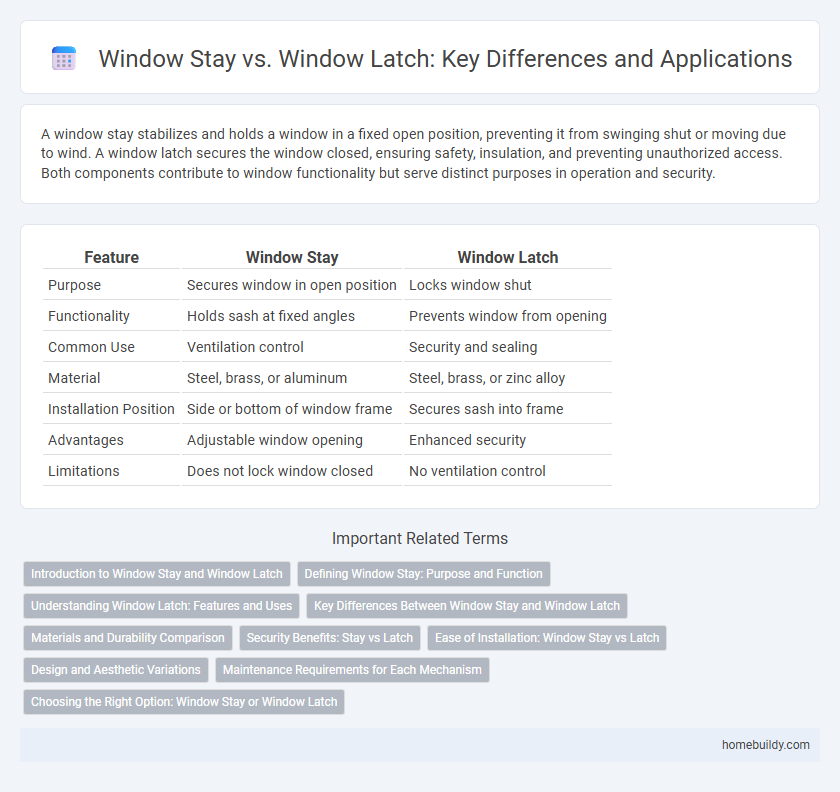A window stay stabilizes and holds a window in a fixed open position, preventing it from swinging shut or moving due to wind. A window latch secures the window closed, ensuring safety, insulation, and preventing unauthorized access. Both components contribute to window functionality but serve distinct purposes in operation and security.
Table of Comparison
| Feature | Window Stay | Window Latch |
|---|---|---|
| Purpose | Secures window in open position | Locks window shut |
| Functionality | Holds sash at fixed angles | Prevents window from opening |
| Common Use | Ventilation control | Security and sealing |
| Material | Steel, brass, or aluminum | Steel, brass, or zinc alloy |
| Installation Position | Side or bottom of window frame | Secures sash into frame |
| Advantages | Adjustable window opening | Enhanced security |
| Limitations | Does not lock window closed | No ventilation control |
Introduction to Window Stay and Window Latch
Window stays provide adjustable support for opening and holding windows in position, enhancing ventilation and security. Window latches function as locking mechanisms that secure windows when closed, preventing unauthorized access and improving safety. Both components are essential for functional window hardware, with stays enabling controlled window movement and latches ensuring secure closure.
Defining Window Stay: Purpose and Function
Window stays are hardware devices designed to hold a window open securely at various angles, providing ventilation while ensuring safety. Unlike window latches, which primarily serve to lock windows shut and prevent unauthorized access, window stays allow controlled opening and stable positioning. Their function enhances airflow without compromising security or window integrity, making them essential for effective window operation.
Understanding Window Latch: Features and Uses
A window latch is a mechanical device designed to secure a window in a closed position, enhancing safety and energy efficiency. Unlike a window stay that primarily controls the opening angle and holds the window in place, a window latch locks the window to prevent unauthorized access and drafts. Commonly made from durable materials like stainless steel or brass, window latches are essential for maintaining security and ensuring the window remains tightly sealed.
Key Differences Between Window Stay and Window Latch
Window stays primarily control the opening angle and secure the window in a fixed position, enhancing ventilation and safety, whereas window latches mainly lock the window shut to prevent unauthorized access. Window stays are often adjustable mechanisms that allow partial opening, while latches focus on providing a firm seal and improved security. Choosing between them depends on whether controlled airflow or enhanced locking is the priority for window functionality.
Materials and Durability Comparison
Window stays are typically crafted from stainless steel or brass, offering superior corrosion resistance and long-lasting durability compared to window latches, which are often made from zinc alloy or plastic. The robust materials in window stays provide enhanced strength and stability, making them ideal for frequently used or heavier windows. In contrast, window latches may wear down faster under regular use due to less resilient materials, impacting overall lifespan and reliability.
Security Benefits: Stay vs Latch
Window stays provide enhanced security by firmly holding the window in a fixed position, preventing forced entry and accidental openings. Unlike window latches, which primarily secure windows when fully closed, stays allow controlled ventilation while maintaining safety measures. The robust design of window stays resists tampering more effectively than conventional latches, making them a preferred choice for securing residential and commercial properties.
Ease of Installation: Window Stay vs Latch
Window stays offer straightforward installation with fewer components, making them quicker to mount compared to window latches, which often require precise alignment and multiple fixing points. The simpler design of window stays reduces the need for specialized tools, enabling easier DIY installation. Window latches may demand professional fitting to ensure secure locking, whereas window stays can typically be installed by homeowners with basic hardware skills.
Design and Aesthetic Variations
Window stays offer a minimalist and sleek design that enhances modern architectural aesthetics by providing unobtrusive support and seamless integration with window frames. Window latches, often bulkier with visible locking mechanisms, prioritize security but can interrupt the visual flow of window design. Selecting between window stays and latches depends on balancing aesthetic preferences with functional requirements, with stays favoring a clean, contemporary look and latches offering more traditional or decorative hardware options.
Maintenance Requirements for Each Mechanism
Window stays typically require regular lubrication and tightening of screws to ensure smooth operation and prevent rust, making maintenance relatively straightforward but essential. In contrast, window latches demand less frequent upkeep but their locking mechanisms may need occasional adjustment to maintain security and proper alignment. Both mechanisms benefit from periodic inspection to avoid wear and prolong functionality, yet window stays often involve more hands-on maintenance due to their moving arms and joints.
Choosing the Right Option: Window Stay or Window Latch
Window stays provide precise control over window opening angles and enhance ventilation, making them ideal for larger or heavier windows. Window latches offer a more straightforward locking mechanism, prioritizing security and ease of use for standard-sized windows. Selecting between a window stay and a window latch depends on the need for adjusted airflow versus secure closure.
Window stay vs Window latch Infographic

 homebuildy.com
homebuildy.com